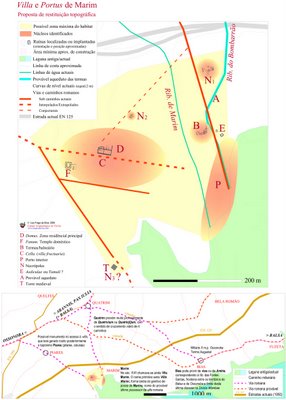Roman Marim.
Topographic and functional reconstitution of the Roman site of Marim
Marim (Quelfes, Olhão, Faro, Portugal) was a notorious Roman non-urban centre, situated by a natural harbour inside the Faro-Olhão lagoon.
Practically destroyed since its discovery in the late XIXth century, Marim became famous by a rich and unusual funerary epigraphic collection of wealthy slaves, some sketches of important roman buildings and diverse archaeological findings, namely a treasure hoard of Honorius.
The site has never been properly studied or, until now, object of a topographic restitution that might shed light upon its morphology, local functionalities and regional placement.
A Historical Geography approach was used, combining the available geo-topographic, archaeological, epigraphic, ethnographic and philological data. Information was analyzed and educated guesses and deductions performed, based on interpretation of sketched buildings, on operational models of coastal, settlement and viary reconstitutions and on analysis of place names, accompanied by contextual historical and geopolitical synthesis.
Roman Marim, situated in the territory of Ossonoba, appears as a occupational complex formed by two nuclei: a luxurious villa rustica with its dependencies and an organized portuary settlement, with a docking area, a balneum, some aediculi (or sacraria), autonomous road access and a well structured cemetery, unique so far in Algarve.
The place name derives very probably from villa Marini (still Vilamarim in the XVIth century), a rather late form of ownership genitive, revealing the name of the last possessor: Marinu.
In our interpretation, the villa might be the official residence of a beneficiari or port administrator official, who had in charge the portuary infrastructure and maintenance of the public service, including baths and hostelry. He might as well be responsible by tax-collection and local security.
The harbour settlement would include a resident population of several officials, besides the slaves (partially identified in the funerary epigraphy) who would fulfil the portuary, baths and personal services workforce.
Know local prosopography allows to propose that, during the IIth century, the villa could belong to a branch of the Anii, an Hispanic gens connected to the Imperial house of the Antonini, well established in Algarve.
The presence of an important private non-Christian temple, built probably by 360 A.D., emulating the neighbouring temple of Milreu (an original and very late example of pagan water cult temple-with-gallery in the Celtic/Germanic fana tradition), shows that the local possessor was then an important personality in the hierarchy of Ossonoba, belonging undoubtly to a rank superior to the local curial order and well acquainted with the architectural tastes of the Imperial Court at Treveris.
It is however unknown the status and official charge of this personality, as well as the title of property of the port (Imperial, Provincial or Municipal), its mode of exploitation (hereditary sinecure, official nomination, public hiring...) and their eventual changes through the Empire history.
The existence of this settlement, with its autonomous balneum in a rural place quite near an important urban centre, is fully justified by the portuary situation and naval quality of Marim's paleobay, protected from all gales and in direct connection with the Eastern lagoon channel from the open sea to the city of Ossonoba.
It would therefore be a port-of-call and a port-of-shelter for the long course navigation coming from the East (Baetica, Mediterranean and Tingitania), with a facility of access superior to Ossonoba's own port (still considerable in the XVIIth century) , avoiding the need of piloting through the narrow lagoon channels.
It would be too, secondarily, a local port of supply and traffic to the hinterland, as shown by its direct road connection to the North, though the main crossroad of Quatrim (from Latin *quatrin[i]um, "four ways").
Could therefore be an alternative port between the Ultramarine destinies and the towns of Southern Lusitania, beyond the Algarvian Mountains (namely to Pax Iulia, the Conventualis capital), following the via Ossonoba-Aranni[s] identified by Antonine Itinerary XXI (item de Esuri Pace Iulia) , whose course can nowadays be established.
Its direct and short access (3.7 m.p.) to the Roman vicus and trivium of Moncarapacho (from late Latin or Mozarabic *mons carapaceum, referring a neighbouring hill "Cerro da Cabeça" with a turtle's carapace shape), the most probable setting of the Stacio Sacra referred in the Ravennate (Rav. IV, 43), also indicates its eventual function as port to the important mountain sanctuary of Monte Figo, identified with the arcis summitas Zephyris vocata (the mountain top dedicated to Zephyr/Favonius, the deified Western Wind) of Avienus' Ora Maritima (O.M. 223-4) and later dedicated to Saint Michael.
The presence of Paleochristian graves and of Late Roman C pottery suggests that Marim stayed inhabited until the Vth century, or even later.


No comments:
Post a Comment